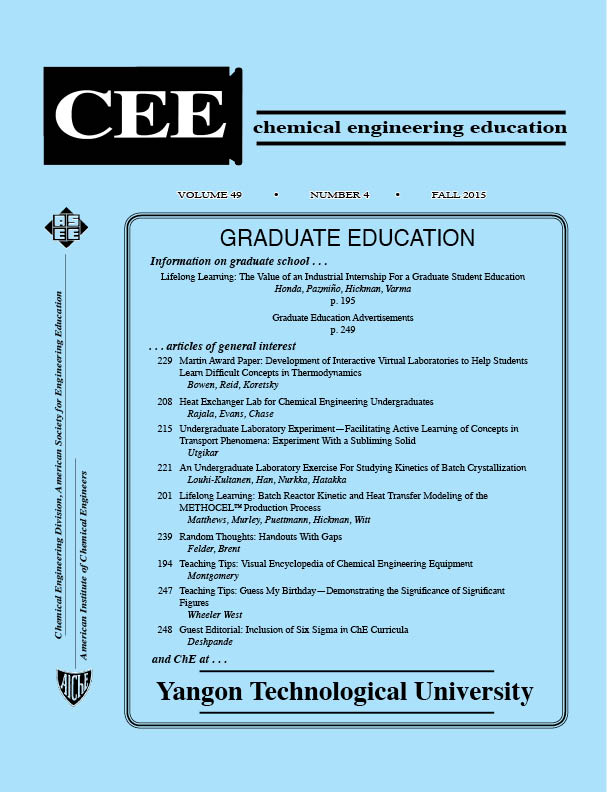Development of Interactive Virtual Laboratories to Help Students Learn Difficult Concepts in Thermodynamics
Abstract
In this project, we explore the use of threshold concept theory as a design basis for development of Interactive Virtual Laboratories in thermodynamics. Thermodynamics is a difficult subject for chemical and biological engineering students to master. One reason for the difficulty is the diverse and challenging set of threshold concepts that they must coherently synthesize and be able to apply in a diverse range of contexts. Based on our experience and from reports in the literature, we have identified a set of threshold concepts we propose are critical for mastery of thermodynamics. To help students better learn these concepts, we have been developing Interactive Virtual Laboratories. This paper describes the development and initial investigation of two such laboratories. They are available for instructors to use through the AIChE Concept Warehouse website (http://cw.edudiv.org/).
The Interactive Virtual Laboratories are a series of two-dimensional simulations designed to address the targeted threshold concepts. The design of these laboratories is based on allowing students to see and explore alternative representations of the phenomena that they are learning. They allow inquiry-based, scaffolded activity, and each has several activities that provide multiple representations. These activities guide students to perform virtual experiments, and also to place the virtual experiments in the context of the concepts that they are learning. They explain concepts in a way that is less abstract and more intuitive to students by providing a dynamic representation of phenomena at a molecular level. Students are expected to answer numerical questions and, whenever possible, predict and explain the effects of macroscopic changes (i.e., pressure, temperature, composition, energy) based on observations of molecular properties.
In the study reported in this paper, we investigate how students experience the laboratories and whether the students perceive the simulations are beneficial towards learning. The two interactive virtual laboratories studied address the concepts of Pv work and reversible processes. Eight participants took part in the clinical study outside of the engineering classroom. All students had previously taken a thermodynamics course and had access to a thermodynamics textbook and the internet as they completed the laboratory. A “think aloud” protocol was used where students were audio recorded as they verbally described their actions in completing the laboratory. The transcribed audio recordings together with video recordings of the computer screen on which they worked were analyzed. After completing the laboratory, a semi-structured interview asked participants about their perceptions of the simulation’s effectiveness, their previous thermodynamics experience, and a brief assessment of what they learned. All interviews were transcribed for analysis.
The participants generally responded positively to the simulations. Seven out of eight students explicitly stated that the dynamic simulations helped them visualize and engage with the processes more than they could with the static depictions in books or lecture. However, some difficulties were observed, including interacting with the interface and understanding specifically what a question was asking. One participant found the interactivity to be unintuitive. We also noticed a relation between how the participants framed knowledge and their approach to completing the laboratory. Students who activated more sophisticated frames typically completed the simulation more quickly and accurately than those with more naive frames. Students who did not do as well tended to focus on trying to identify equations they had used in the past, even going so far as to use them in an unsuitable context. On the other hand, students who completed the simulations accurately and more quickly appeared to integrate what they were seeing on the screen with their foundational conceptual knowledge to form new understanding.


